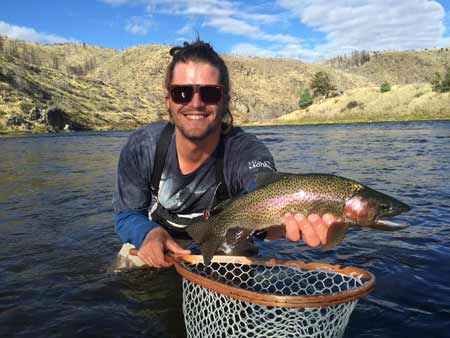Big Sky Wildlife Spotlight: Rainbow Trout

Chase Navratil with a Rainbow Trout
There's a good chance that if you visit or live in Big Sky, Montana, you're going to try fly fishing at some point. If you're heading down to the Gallatin River or to a tributary stream near Big Sky, you might get lucky and catch a rainbow trout. It's one of the most popular wild fish in this area.
Rainbow trout are only native to rivers and lakes in western North America. Yet due to their popularity, these fish have been introduced throughout North America - including most of Montana. In fact, rainbow trout now thrive in every continent except Antarctica. Rainbow trout are now a part of the Big Sky ecosystem - and they are a blast to try and catch!

Chase Navratil with A Rainbow Trout
Let's take a look at some interesting facts about rainbow trout:
- The scientific name for Rainbow Trout is Oncorhynchus mykiss.
- Rainbow trout have beautiful coloring. Colors and patterns vary based on environment, age, and spawning condition.
- They are members of the salmon family.
- The usually range from 20 to 30 cm long and weigh about 8 pounds.
- The largest rainbow trout ever caught was 57 pounds and estimated to be 11 years old. The Montana state record is 33 pounds.
- Rainbow trout were introduced to Montana beginning in 1889. The Montana Field Guide says that scientists believe that only the rainbow trout of the upper Kootenai River drainage are native to this state.
- Rainbows are the #1 game fish in Montana.
- There are 15 subspecies of rainbow trout
- Rainbow trout are carnivores that eat insects, crustaceans, and small fish.
- They live an average of 4 to 6 years in the wild.
- A group of rainbow trout is called a hover.
- Rainbow trouts have been introduced to every continent except Antarctica.
- They prefer a temperature range of 32 to 70 degrees Fahrenheit
- This fish has been commercially farmed since 1870.
- Rainbow trout are rich in Omega-3 fatty acids.
- Female rainbows can spawn 200 to 8000 eggs per season.
- Rainbows usually spawn in the spring at age 3 to 4.
- Rainbows always try to return to spawn in the same part of the river that they were hatched.
- Predators of rainbow trouts include, kingfishers, eagles, herons, eagles, raccoons, and humans.
- Rainbow trout have seven fins - pectoral fins (2), pelvic fins (2), anal fin, dorsal fin, adipose fin.
- Rainbows have teeth on the roof of its mouth but no lower teeth.
- A rainbow trout's nest is in the gravel at the bottom of the water. It's called a redd.
- Rainbow trout can only survive in clean water.

Ethan w/ Rainbow Trout
Go fishing in Big Sky Country and you'll likely run across a rainbow trout. These stunningly beautiful fish are fantastic fun to catch and they taste good too. If you want to fish for rainbow trout, book an experienced, local, and licensed fly fishing guide to show you the lakes, streams, and rivers of Big Sky Country.
See Also:
- Big Sky Wildlife Spotlight: Moose
- Big Sky Wildlife Spotlight: Bighorn Sheep
- Big Sky Wildlife Spotlight: Wolves
- Big Sky Wildlife Spotlight: Mountain Goats
- Big Sky Wildlife Spotlight: Elk
- Big Sky Wildlife Spotlight: Grizzly Bears
- Big Sky Wildlife Spotlight: Bison

